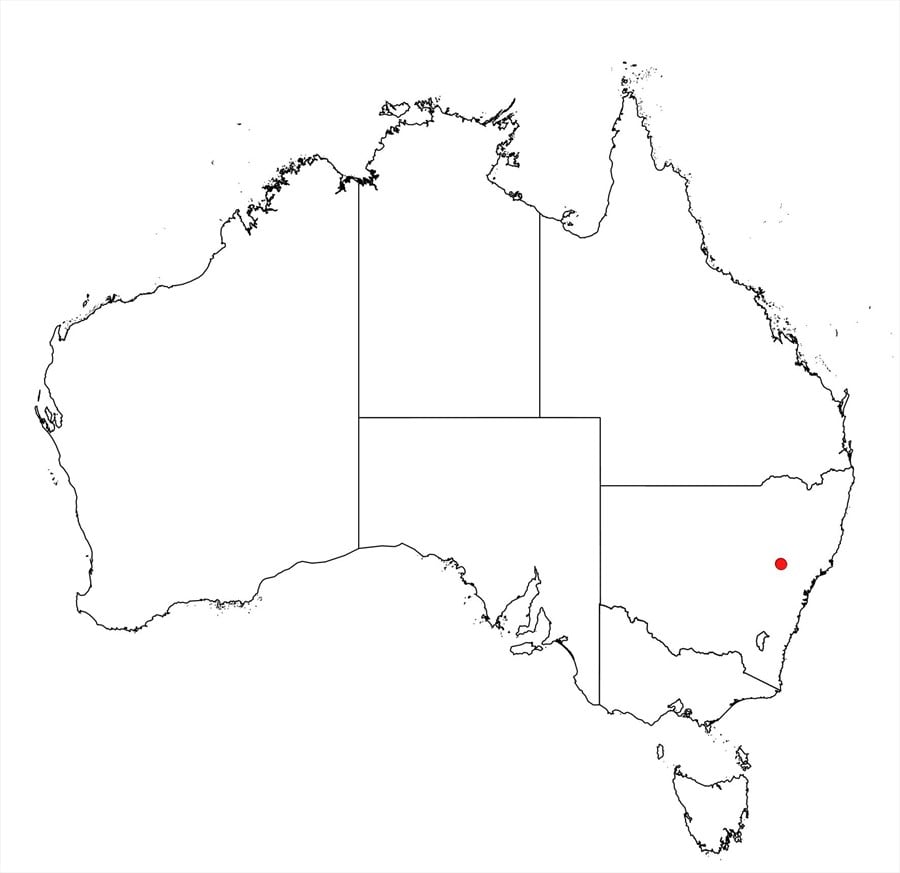Acacia wollarensis S.A.J.Bell & Driscoll
WATTLE
Acacias of Australia
Common Name
Wollar Wattle
Family
Fabaceae
Distribution
Known only from the Parish of Wollar in the upper Hunter Valley, 120 km W of Muswellbrook and 50 km NE of Mudgee, New South Wales; see S.A.J. Bell & C. Driscoll, Telopea 20: 129, fig. 3 (2017).
Description
Tree 12–20 m high. Bark smooth, greyish, becoming rough, furrowed and brown with age. Branchlets terete with broad rounded ridges, densely villous with spreading white hairs (smaller hairs 0.3–0.5 mm long forming a continuous indumentum, with scattered emergent longer hairs 0.7–1.0 mm long). Leaves obovate in outline, pale light green on new growth, mid-green when mature, ±sessile; petiole 0.2–0.4 cm long, densely villous; rachis 5.3–9.5 cm long, prominently and narrowly-ridged above, densely villous with spreading white hairs c. 1 mm long; jugary glands prominently raised, circular to broadly elliptic, 0.6–1 mm diam., at base of upper 1–4 pairs of pinnae and occasionally on lower 1 or 2 pairs; pinnae 10–14 (–16) pairs, 13–61 mm long, lowermost pairs shorter than others, near-uppermost pairs the longest; pinnules 6–26 pairs, oblong-subulate, 3–6 mm long, 1–1.7 mm wide, dark green above, paler green below, setose with scattered white bristles to 0.5 mm on upper side, confined to margins and midvein below, margin recurved, apex obtuse to subacute. Inflorescences in terminal and axillary racemes and panicles. Peduncles 4.5–6.5 mm long, white appressed-pubescent. Heads globose, c. 24–31-flowered, c. 4–6 mm diam. (when dry), golden yellow. Pods straight to slightly curved, moniliform, margin moderately and ± regularly constricted between seeds, distinctly raised over seeds, 9–13.5 cm long, 7–9 mm wide, coriaceous, green becoming light to dark brown at maturity, with fine raised and reticulate lateral veins, scattered white setose with hairs to 0.6 mm long.
Phenology
Flowers recorded in Sept.; pods with mature seed collected Dec.–Jan.
Habitat
Grows in sheltered gullies or on mid to lower slopes, at the interface of Triassic Narrabeen sandstones and Permian claystones and shales. Sometimes forms a dense sub-canopy below Eucalyptus punctata and E. sparsifolia. For more details see Bell & Driscoll (2017).
Specimens
N.S.W.: near Wollar, Upper Hunter Valley, 4 Sept. 2014, S.A.J. Bell s.n. & C. Driscoll (NSW); opposite “Wollarah Downs”, Wollar, S.A.J. Bell 4936 & C. Driscoll (DMHN, K, PERTH); NE of Wollar, 1 Oct. 2015, C. Driscoll s.n. (AD, MEL) and 3 Nov. 2015, C. Driscoll s.n. (NSW).
Notes
Diagnostic Features: Acacia wollarensis has affinities to Acacia fulva and the rare A. chrysotricha, but differs from these most prominently in the densely white-setose rachis and pinnules. Affinities are described in detail by Bell & Driscoll (2017).
Conservation
Known only from two populations and under IUCN guidelines qualifies as Vulnerable.
FOA Reference
Flora of Australia Project
Author
S.A.J. Bell & P.G. Kodela
This identification key and fact sheets are available as a mobile application:
URL: https://apps.lucidcentral.org/wattle/
© Copyright 2018. All rights reserved.






